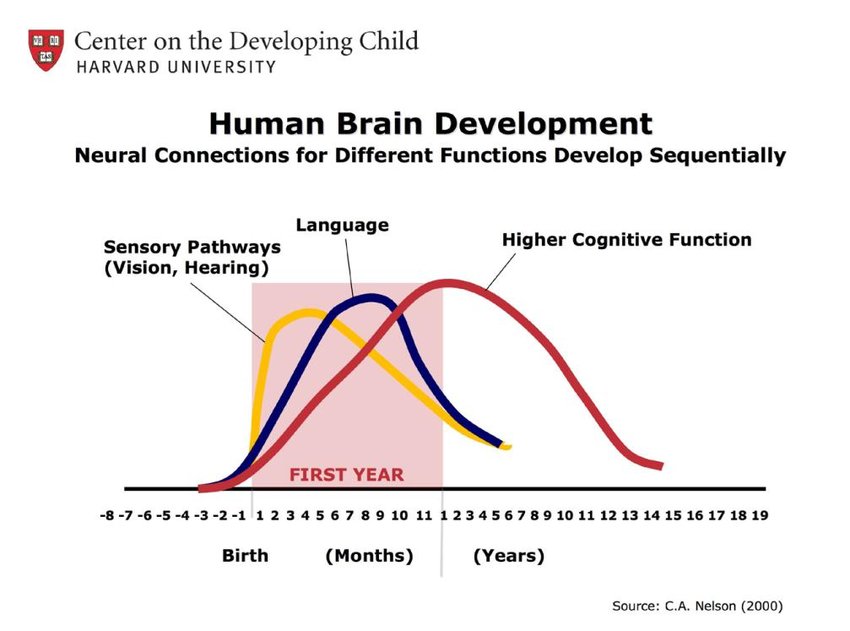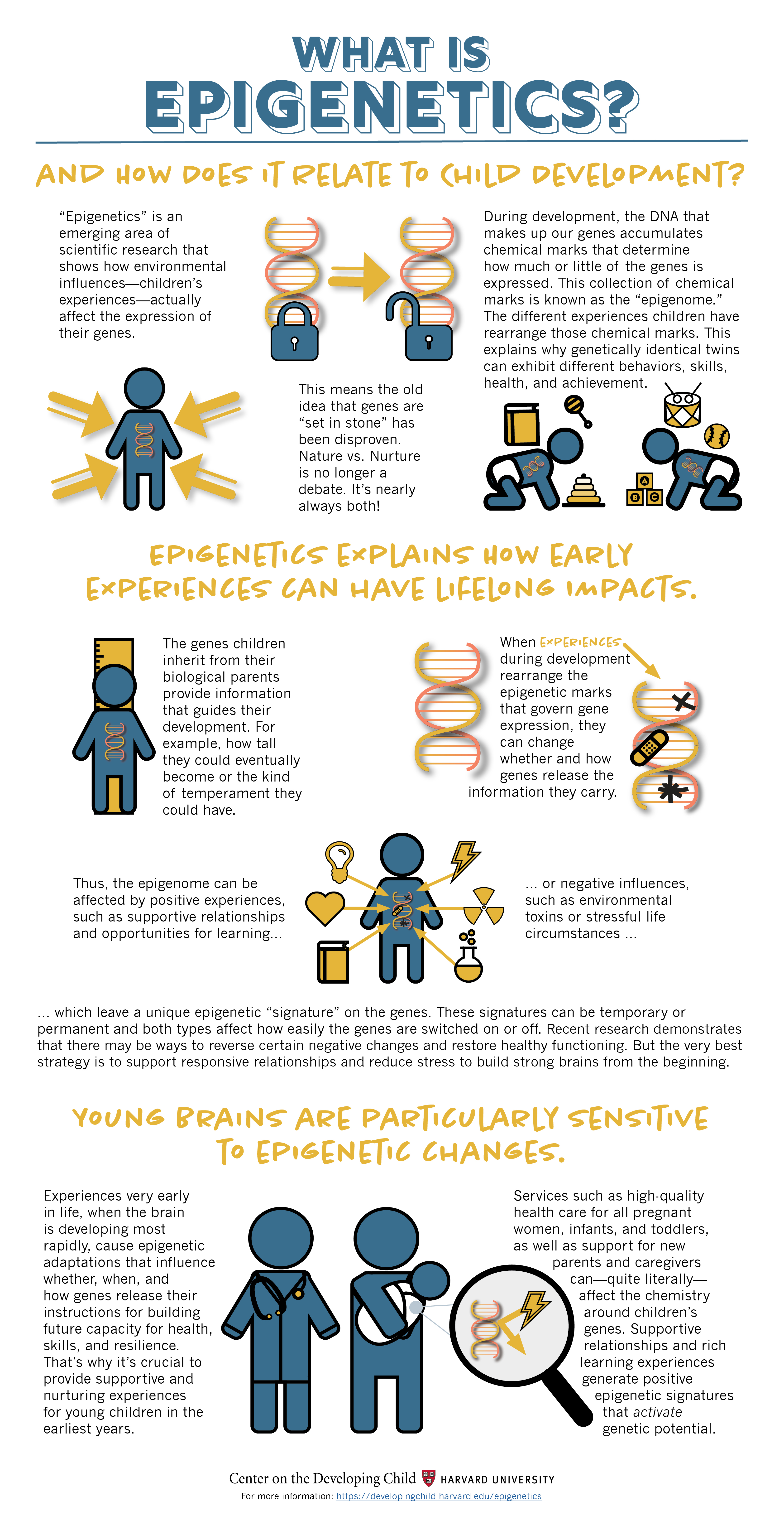The human brain is a complex organ central to cognitive and emotional functions. It is made up of several key structures that develop rapidly during the preschool years.
- The cerebrum, the largest part, is responsible for higher brain functions, including thought, memory, and voluntary movement. Its outer layer, the cerebral cortex, undergoes significant growth, enhancing abilities like problem-solving and language.
- The cerebellum, situated at the back of the brain, coordinates movement and balance, crucial for the physical activities common in young children.
- The brainstem, connecting the brain to the spinal cord, controls essential life functions such as breathing and heart rate.
As these regions develop, children exhibit remarkable advances in motor skills, language acquisition, and social interaction, highlighting the importance of early childhood experiences in shaping brain development. Children who experience nurturing environments in their early years are more likely to develop good cognitive, social and emotional skills, whereas children exposed to neglect, poverty or trauma are more likely to have lasting behavioural and cognitive problems (Nhnscr, 2023).
Each brain hemisphere is divided into four lobes which each control specific functions.
This is the largest lobe and is at the front of the head. The frontal lobe controls personality, movement and decision-making. It also partly controls recognition of smell and speech.
This lobe is involved in the identification of objects and the understanding of spatial relationships. It also has some involvement in interpretation of pain and touch and helps in understanding spoken language.
This is at the back of the brain and is involved in vision
The temporal lobe is involved in short-term memory, musical rhythm and some degree of smell recognition (Brain Anatomy and How the Brain Works, 2021).
Cerebellum
The cerebellum’s function is to co-ordinate voluntary muscle movements and maintain posture, balance and equilibrium. It is also believed to have a role in thought, emotions and social behaviour and studies are exploring the link between the cerebellum and addiction, autism and schizophrenia (Brain Anatomy and How the Brain Works, 2021).
Other key parts of the brain
The hippocampus is a part of the brain crucial for memory and learning. It undergoes rapid development from around 32 weeks of gestation and is involved in a child’s ability to form and recall memories, including learning new information and navigating their environment. As it matures, the hippocampus supports better memory retention and spatial awareness, which is crucial for activities like remembering names, following directions and understanding routines.
The prefrontal context in located at the front of the frontal lobes and is responsible for complex processing such as attention, multi-tasking, impulse control and social behaviour. The prefrontal cortex grows rapidly from 6 months of age (NCBI - the Role of Nutrition in Brain Development, 2016).
The amygdala’s main function is to regulate emotional responses, including feelings of happiness, fear, anger and anxiety. It is also key in the formation of new memories and interacts with the hippocampus. Damage to the amygdala can result in more aggression, irritability, loss of control of emotions and reduced ability to recognise emotions (MSc, 2024).
This group of structures regulate voluntary movements, including eye movements and helps with balance and posture. They have a role in rewards and reinforcement behaviours and can be linked with addictive behaviours and the formation of habits. emotions (MSc, 2024).
The thalamus is a relay centre in the brain with processes and transmits sensory and motor signals to the cerebral cortex and regulates consciousness, sleep and alertness. Much of the information which reaches the cerebral cortex is sent to its destination via the thalamus(MSc, 2023).
This small area of the brain is responsible for producing hormones which regulate heart rate, body temperature, hunger and the sleep/wake cycle (Johnson, 2023).
Watch
Brain anatomy & function | Easy science learning video
A simple description of the anatomy of the brain explaining the key functions of different parts.
Expected Duration: 4:45 minutes
Questions
Pre Watch Question: Note down any extra information about the function of parts of the brain.
Post Watch Task: How does understanding the physical construction of the brain help a kaiako to understand the behaviour and development of tamariki?

Brain development is not linear, each area develops at different times and at different rates. The timing of significant life events (e.g. toxic stresses, environmental factors, poor nutrition etc.) can have varying effects on different aspects of brain anatomy and brain function.
By the age of 2 years, a child’s brain has reached 80% of its adult size; the first three years of a child’s life are the most crucial in brain development. During this time it is most receptive to experiences and stimuli which can affect a child’s future growth and development.
The Five Stages of Brain Development
In this stage, the brain grows rapidly to develop essential structures and systems to support survival and growth. The cerebral cortex begins to form during this period.
As the brain continues to grow, new neurons and synapses are rapidly formed. The prefrontal cortex begins to develop.
During this stage, the growth rate of the brain slows and the focus shifts to refining existing neural connections and networks. The development of the prefrontal cortex continues, and language and social skills flourish.
At this stage, the brain undergoes pruning, where weak or unused neural connections are eliminated to increase efficiency. A child’s cognitive skills, such as problem-solving and decision-making, become more sophisticated.
The final stage of brain development involves the maturation and stabilisation of the prefrontal cortex. A child’s executive functions, such as planning, organising, and thinking abstractly become fully developed.
Brain development in the first twelve months
Though the brain keeps developing into adulthood, the first twelve months show the most rapid growth (Nhnscr, 2023).
Newborns have poor eyesight. They use their sense of touch and hearing to make sense of the world around them. They can recognise voices and tell between familiar and unfamiliar sounds.
Infants start to develop hand-eye co-ordination. They can track moving objects visually and can now recognise caregivers’ faces and respond to social cues like smiles.
Infants become more interactive and show significant social engagement and vocalisation. They can now reach for and grasp objects.
Infants can now sit up unassisted and could start crawling. They are able to understand simple words and may begin babbling.
Infants can pull themselves up to stand and may even take their first steps. They can respond to their names and engage in basic communication.
Infants become more co-ordinated and mobile. They explore their environment and develop their cognitive skills and can say simple worlds and understand basic commands.
(adapted from nhnscr.org)
Physiology of brain development.
![[ADD IMAGE'S ALT TEXT]](/sites/default/files/UNESCO.jpg)
This is the process which occurs in the first few months of life. At birth, a baby’s brain has around 100 billion neurons. During neural proliferation, the neurons divide and multiply resulting in an increase in their number.
After proliferation, neurons migrate to their permanent locations in the brain. This process is critical for the development of brain structure and function and is guided by chemical signals and environmental cues.
Once neurons have migrated to their final locations, they begin to form connections with other neurons. This process is called synaptogenesis and is crucial in the development of brain networks and the establishment of communication between brain regions.
This is the process by which the brain’s white matter is formed and involves the growth of myelin, a fatty coating around the axons of neurons. Myelination speeds up the transmission of signals between neurons, which is essential for brain function.
Activity
Watch this interactive video on Experiences Build Brain Architecture which will ask you questions as you watch.
Psychology of brain development
Psychological factors also play a significant role in brain development during the first five years of life. The following are some of the key psychological factors that contribute to brain development in young children.
Touch, sound and visual stimuli play an important role in brain development. Experiences which engage a child’s senses help to form neural connections which are essential for learning and cognitive development
This is critical for brain development in young children. As they learn language, children form connections in their brain between words and concepts, which helps to develop their cognitive abilities.
Through social interaction children learn to recognise and respond to social cues, essential for developing social skills and emotional intelligence.
The formation of secure attachments between young children and their caregivers is essential for healthy brain development. Secure attachments provide children with a sense of safety and security which helps to promote healthy cognitive and emotional development.
The brain’s growth and development depends on several factors, including
- Genetics
The genes a child inherits from their parents determine many of the brain’s structural and functional characteristics. Genes influence the development of the brain’s basic architecture, such as the number and location of neurons and synapses. Genes can promote good cognitive and emotional development, for example high IQ or resilience to stress but they can also pass on the risk of brain disorders such as Alzheimer’s disease or autism or lead to developmental delays. - Environment
The environment is a critical factor in brain development and includes both physical and social environments such as the home, the school and the neighbourhood. The environment can influence brain development through factors such as nutrition, exposure to toxins and stress.
Positive environmental factors provide exposure to a variety of stimuli promoting brain development, such as opportunities for learning and social interaction. Good nutrition, access to medical care and a safe and supportive environment are also beneficial for healthy brain development. Negative environments such as exposure to toxins can damage the developing brain.
Negative factors such as an unstable or unsafe home environment, poverty and lack of access to quality early childhood education can contribute to poor development overall and in some cases can lead to a “delayed or disordered trajectory”. Stressors such as these can have an effect on the child throughout their life, affecting learning, health and financial outcomes. On the other hand, positive factors introduced to the child’s environment, such as good health care and nurturing parenting or caregiving can alleviate these stressors and allow the child to return to a healthy trajectory (Robinson, 2017). - Experiences
Experiences play a critical role in shaping brain development and the types of experience the child has in the first few years of life can have a lifelong effect on cognitive, emotional and social development.
Positive experiences can involve activities such as interactive play, stimulating learning activities and nurturing care from caregivers. These experiences can promote healthy brain development by developing the neural networks responsible for language, social/emotional skills and executive function.
Negative experiences include exposure to violence, poverty or neglect. These can lead to developmental delays, emotional difficulties and cognitive deficits. Traumatic experiences can lead to an overactive stress response, which can negatively impact brain development and result in long term mental and physical health problems.
This is a term which refers to the first 1000 days of a child’s life, from conception to 2 years of age. It has been identified as a significant period in the development of the child’s brain as well as his/her body and immune system. The baby’s environment, nutrition and relationships during this time can have life-long effects on that person. (The First 1,000 Days, n.d.)
Watch
Nathan Wallis – First 1,000 days
An explanation of the significance of the first 1,000 days from conception on brain development.
Expected Duration: 2:41 minutes
After watching the short video, listen to a more in-depth interview with Nathan Wallis broadcast on Radio New Zealand.
Listen
How the brain develops: from newborn to adult
Even before birth, babies are busily data-gathering, says brain researcher, parenting coach and founder of X-Factor Education, Nathan Wallis. He tells Kathryn Ryan how parents can support young children through the four stages of brain development.
Expected Duration: 16:47 minutes
Reading
The first 1,000 days
An article explaining the first 1000 days for brain developments, with links to more information on key points. There is a quiz to fill in missing words based on the article linked below.
Expected Duration: 7 minutes
URL: https://www.pregnancybirthbaby.org.au/the-first-1000-days#backToTop
Post Read Task: Complete the quiz activity below to fill in the missing words from the article.
Nutrition in the first 1,000 days
Nutrition is key to healthy brain development from the time of mid-gestation to 2 years of age. It is crucial for optimal growth, development and long-term health. Early exposure to a variety of healthy foods helps to establish life-long dietary preferences which can help to reduce the risk of nutritional deficiencies and chronic diseases later in life.
- During pregnancy, good nutrition supports the development of the baby’s brain, organs and general growth. Nutrients such as folic acid, iron, calcium and omega-3 fatty acids are particularly important at this time.
- Breastfeeding provides the required nutrients as well as immunity factors which support the infant’s growth and helps protect them from infections.
- At around 6 months the introduction of healthy solid foods is essential to meet the energy and nutrition demands of the growing child.
Watch
Nutrition and brain development
A guide to the some of the key nutrients essential to a child’s development and their biological function
Expected Duration: 4:48 minutes
Reading
How does nutrition affect the developing brain?
Brain development is most sensitive to a baby’s nutrition between mid-gestation and two years of age. This article adds more detail to what we have already learned.
Expected Duration: 15 minutes
URL: https://www.zerotothree.org/resource/distillation/how-does-nutrition-affect-the-developing-brain/
Activity
- Download and read the Ministry of Health /Ministry of Education guide to Healthy Food and Drink Guidance for Early Learning Services.
- How does nutrition impact a child’s brain development during their early years? The interactive video below covers the first 1000 days, responsive feeding, which foods are best, iron rich foods and how to feed and asks you questions as you watch. Note down key points about how a kaiako or parent can promote healthy eating habits in young children.
- Make sure you have read the instructions for assessment 03A2 task 1.
Epigenetics is a relatively new area of scientific research into the effect of environmental factors and children’s experiences on their genes. It explores how factors such as diet, stress and environment can influence gene expression, but without altering the underlying DNA. The correlation between experiences and genes is important as it speaks to the age old question of “nature vs nurture”. It suggests that both are important in determining outcomes for the rest of a child’s life. The implication for parents, caregivers and early childhood educators is clear, indicating that providing the child with a positive, nurturing and safe environment and relationships is very important in determining the future of the child. (What Is Epigenetics? The Answer to the Nature Vs. Nurture Debate, 2020)

From the studies conducted, some key points have been made regarding the impact of environmental factors on child development: (Epigenetics: Child Development and Genes, 2019)
Contrary to previous thinking, the genes a child inherits from his/her parents are not fixed but are susceptible to being expressed differently. The Harvard report states “The environment in which one develops, before and soon after birth, provides powerful experiences that chemically modify certain genes which, in turn define how much and when they are expressed
“Injurious experiences, such as malnutrition, exposure to chemical toxins or drugs and toxic stress before birth or in early childhood are not ‘forgotten’ by the developing child”. Adverse experiences such as those described can alter the architecture of the developing brain and thereby increase the risk for “poor physical and mental health outcomes” or “impairments in future learning capacity and behaviour”.
Harvard researchers discovered that a child’s memory and capacity to learn was developed more strongly if the connections in the brain responsible for memory and learning were repeatedly stimulated. They coined the term “serve and return” to describe this process and involves multiple interactions between the adult and the young child.
Whilst positive experiences, such as those described by “serve and return” can impact the expression of a child’s inherited genes (epigenome), negative factors, such as toxic stress, also affects the epigenome. Researchers say that it is possible to reverse the negative genetic effect, but this is much more difficult than the switch in the brain which activated it in the first place.
(What Is Epigenetics? The Answer to the Nature Vs. Nurture Debate, 2020) (Epigenetics: Child Development and Genes, 2019)
You can read more about the science behind epigenetic theory in this BBC article
Serve and Return

“Serve and Return” is a phrase coined by Harvard University researchers to describe how back-and-forth interaction between a young child and an adult can be beneficial to the development of the child’s brain.
(An Introduction to Serve and Return, 2020)
Watch
Serve & Return Interaction Shapes Brain Circuitry
One of the most essential experiences in shaping the architecture of the developing brain is "serve and return" interaction between children and significant adults in their lives. Young children naturally reach out for interaction through babbling, facial expressions, and gestures, and adults respond with the same kind of vocalizing and gesturing back at them. This back-and-forth process is fundamental to the wiring of the brain, especially in the earliest years.
Expected Duration: 1:42 minutes
Post Watch Task: After watching this video, watch the next one which is interactive and has questions to complete based on the information it gives.
Activity
Watch this interactive video from Harvard University’s Centre for the Developing Child about 5 steps for Brain-Building Serve and Return and answer the questions based on the information given.
Toxic Stress
Some forms of stress can have a positive effect on a person, for example some stresses can motivate someone to try hard to achieve positive and progressive outcomes (like a child performing a school drama or musical performance) and are a normal part of healthy development. However, toxic stresses can have a harmful effect on a young child’s brain development and are a result of prolonged, strong adversities. Examples of toxic stress include abuse (physical or emotional), neglect, caregiver substance abuse, violence in the home and poverty. How the stresses are handled by the responsible adults can determine how severe their effects are on the child – healthy support from an adult can mitigate the stressor and make it tolerable rather than toxic.
Toxic stress can have a profound effect on the young child’s developing brain. The resulting over-activation of the Hypothalamic Pituitary and Adrenal (HPA) hormone axis leads to abnormally high levels of cortisol, a hormone which is released in response to stress and can have long-term affect on immunity and inflammation and is associated with changes in brain structure. (Toxic Stress: How the Body’s Response Can Harm a Child’s Development, 2017). It can alter the chemistry and anatomy of the brain, and this can lead to long-term difficulties in learning, behaviour, mental health and even physical health.
Watch
How toxic stress affects us, and what we can do about it
For those who've experienced toxic stress, just getting through the day can feel tough, let alone being the best parents or caregivers you can be. In this video, learn more about what toxic stress can feel like, and practical steps you can take to feel better and build resilience for yourself and your children.
Expected Duration: 3:51 minutes
Post Watch Task: Watch the next interactive video about how toxic stress can derail healthy development
Activity
Watch and answer the questions in this interactive video “Toxic Stress Derails Healthy Development”.
Foetal Alcohol Spectrum Disorder
One example of a developmental manifestation of a toxic stressor is Foetal Alcohol Spectrum Disorder.
Watch
What is FASD?
A short video that explains what Foetal Alcohol Spectrum Disorder is and the impacts it can have on an individual.
Expected Duration: 3:11 minutes
Questions
Pre Watch Question: What do you already know about FASD?
Post Watch Task: Research further in to the effects of alcohol on brain development in children from the womb to early childhood.
Activity
- Summarise the key effects of this condition. Compare and contrast the brain development of a child diagnosed with FASD with to that of a child with normal brain development to explain the possible long-term effects of the condition. You can start with this site for detailed information.
- How is the New Zealand health system managing this condition? Look here for information.
- Write a short explanation of how knowledge of the effects of FASD, or other toxic stressors could affect your practice in an ECE service.
- Now watch this interactive video and answer the questions in it.
- Use the information you have read and seen to work on assessment 03A2 task 2
You’ve reached the end of this topic. Let’s go over the key points:
- The human brain is made up of several structures controlling different physical and psychological functions.
- The brain develops rapidly during pre-school years and the first three years are the most crucial.
- Brain development can be affected by adverse events and conditions.
- By the age of 2 years, the human brain is around 80% of its adult size.
- Psychological factors play an important role in brain development in the first five years of a child’s life.
- Brain development can be affected by genetics, environment and experiences.
- The first 1,000 days are important in the development of a child’s brain, body and immune system. Having a good environment, good nutrition and good relationships in this time has beneficial life-long effects on that person.
- Epigenetics explain that environmental factors like stress, diet and environment can negatively impact the expression of the body’s genes without altering DNA.
- Serve and Return is a concept from Harvard University which describes the benefits on brain development of back-and-forth interaction between a young child and an adult.
- Toxic stress includes abuse, neglect, caregiver substance abuse, domestic violence and poverty and can have a negative effect on a young child’s developing brain.
- FASD is an example of a toxic stressor which can have life-long negative effects on the individual.
